Want to markedly increase the potency of your cannabis plants? Plants with higher total levels of cannabinoids and terpenes? Then read on to discover the 6 ways to stress your plants for greater potency.
And yes, we know there are many more than 6 factors to growing your plants successfully. But in this article, we will only highlight these 6 growing factors that matter when aiming to positively stress your plants. For example, your growth medium and fertilizer use are very important for overall success, but they aren’t factors you can intentionally manipulate to create positive stress to increase potency.
But before we get into the nitty-gritty of how to stress your plants, a few notes to set you up for success:
Positive, intentional stress versus negative, unintentional stress:
When we talk about stressing your plants, what kind of stress matters. We are aiming only for intentional, positive stress that is proven to help the plant increase its potency. These are stressors that you control and do on purpose. We are NOT advocating other kinds of negative, unintentional stressors (like equipment failure) that happen because of bad luck, mistakes, carelessness, or neglect.
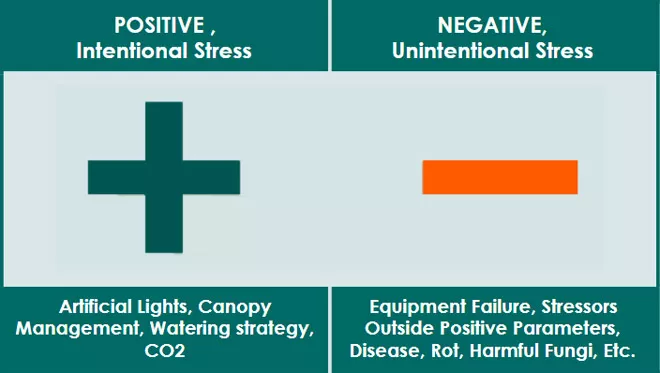
Genetics matter:
If you are going to invest all the extra time to intentionally stress your plants to get a higher potency product, you need to start with a genetic strain that is worth working with, that will have even more potential if stressed. If you have a poor strain to start with, no matter how well you stress it, you won’t get a unique or valuable product. It would be like putting a turbo on a Hyundai. You need to start with a Porsche-level strain, not a Hyundai-level strain.
Allow enough time:
Your overall crop strategy must allow enough time to permit intentionally stressing your plants. You wouldn’t want to arbitrarily harvest your plants according to a strict time schedule if it prevents you from waiting for the perfect timing of harvest, based on cannabinoids analysis feedback.
Indoor growing best:
While some of these stress strategies can be applied in every kind of growing environment, you can only do all 6 of these stresses within an indoor environment. Indoors you can best control these positive stress factors, compared to outdoors and greenhouse cultivation where you have less control.
Harvest by hand:
One last bit of advice: If you are going to invest so much extra effort in intentionally stressing your plants to make a higher quality product, then harvest by hand, as the slow and cool-temperature hang dried method maintains the terpene levels. Otherwise, if you harvest your plant with a mechanical, motorized, wet trim, you kill the quality of your product, and waste all your extra effort. It would be like getting a Porsche, and then adding low octane gas and bald tires to it.

6 WAYS TO POSITIVELY STRESS YOUR CANNABIS PLANTS
1. Artificial lighting:
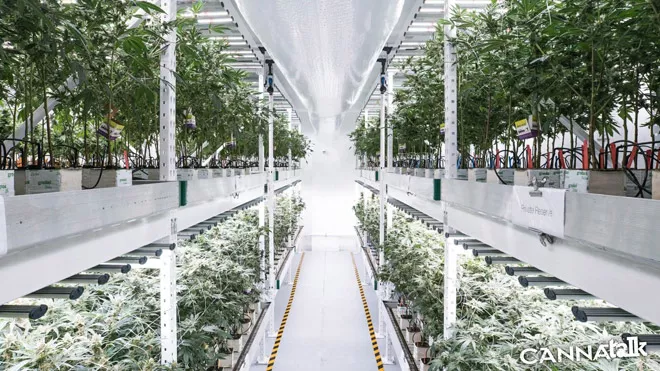
Of all the positive ways to stress your plants, artificial lighting is the most important. If you don’t have good lights, you for sure won’t achieve high potency. And the light fixture most commonly used by growers is the double-ended High-Pressure Sodium light. DE HPS lights are the most intense for the lowest cost by unit but cost more than LEDs to operate.
To achieve high potency by stressing your crop with artificial lights, make sure you have full intensity lights on your plants as long as you can. The typical flowering cycle goes for 12 hours a day. So, the key is to have 100% of your intensity as long as you can in your light cycle. When your lights are on, they’re really on!
And if your lighting system allows, adjust your light level depending where you are in the growth cycle. When you start the crop, dim down your lights, perhaps turning off one or two lights out of four, just to give your crop a chance to start properly. But as soon as your plants can handle more light, boost the intensity to full power, and if possible, adjust the physical height of the fixture vs the canopy level: Start high and lower as soon as the plants are responsive.
Another aspect of stressing your plants with light is to get your lights closer to your plants. Just be sure you are aware of how that affects leaf temperature and humidity (which we will discuss later).
2. Canopy management:
Canopy management is how you manipulate your plants to optimize the light penetration to your flowers -- it’s all about distributing energy to the right parts of your plants.
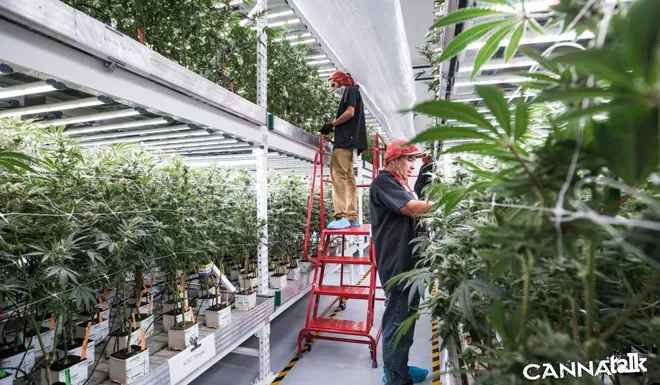
| Topping: Cutting off the apex (head of the plant) | Fimming: Multiple topping of plants |
|
Image

|
Image

|
| Netting: Trellis installation to support the flowers’ weight | Fimming: Removing the plants’ lower branches |
|
Image

|
Image

|
| Low-stress training (LST) or Bending: Slightly bending your plants’ branches | High-stress training (HST) or Supercropping: Gently and purposely scar plant stems in multiple places |
|
Image

|
Image

|
| Screen of green (SCROG): Threading plant stems through a rope or string grid | Sea of green (SOG): Smaller plants cultivated and flowered in very high density |
|
Image

|
Image

|
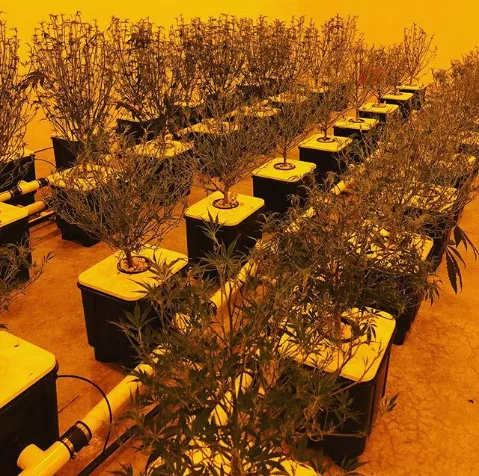
Matt Daley instagram pic @constructedrealities
Some of these canopy management terms are about stressing your crop, while others are related to the density of the plants. We are not going to define them here, except to say that overall, it’s simply about training your plants and changing how they are arranged so they get more light.
When you do step #1 and provide more artificial light, with #2 you manage your canopy to get more of that increased light on your plant flowers at the right height. Which increases and helps standardize the potency even further than if you did #1 artificial lights alone.
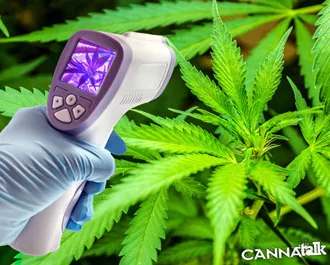
Non-Contact Sight check
3. Temperature
Lower temperatures at the end of your flowering cycle (for only a few days to at most the last two weeks) can positively affect plant colors and potency. Some terpenes are highly volatile in cooler environments at 10, 15, or 20 degrees Celsius, it minimizes the volatility. This temperature range can maintain the terpene level and strength.
However, growers have to be vigilant when lowering the temperature because then it gets more challenging to manage the humidity level which invites potential bud rot. So, the growers’ game is to play with this within the acceptable limit.
And you can measure the combination of the temperature and humidity as your Vapor Pressure Deficit, or VPD. Which is in itself another positive stressor, and is our next point.
Another way to use temperature to stress plants is via the water temperature. It is not very commercially viable, but some closet growers use cool water or even ice to drop the temperature and stress their plants.
4. Vapor Pressure Deficit (VPD)
The VPD value is extremely useful because it tells you so much with just one number about your plants and their likely reaction to their environment. With cannabis, the VPD ranges between about 0.5 and 1.5. The VPD value tells you when your plants’ stomata (which are like the pores on their leaves) are open or closed. When the stomata are fully open, your plant is thriving and producing using photosynthesis. When the stomata are closed, the plants are more stressed. So, you can use the VPD as a tool to affect your plants’ stomata and increase the positive stress on your crop.
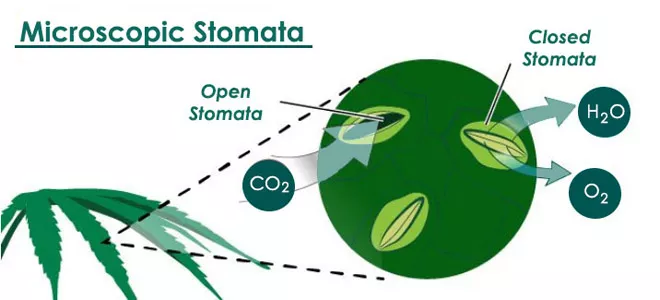
But, timing along the growth cycle affects how much you stress your plants with VPD. Every grower has their own growth recipe, with their own targeted data points, including the VPD, through each phase of your grow cycle and flowering cycle. And for positive stressing, you need a different VPD target range along different parts of the growth cycle. Toward the end of your crop, you increase your VPD to close the stomata to stress your plant. That gives more generous blooming. But if the stomata are closed in a phase when you don’t want to be closed, that is a problem, and could be a negative stressor.
Also, your HVAC settings, like the air distribution and the air movement, have a direct effect on your VPD. Your HVAC system and also your lights (how physically close they are to your plants) helps you control how much stress you are putting in your plants.
5. Water irrigation
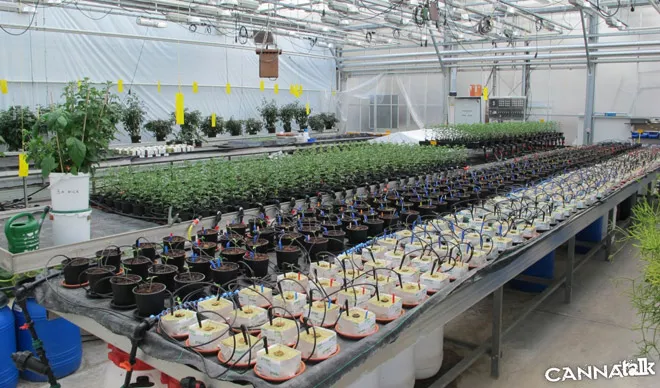
When we plan to stress plants via water irrigation, it is very important to discern between the quantity of water and the frequency water delivered. Because overall, how we stress a crop with water is the frequency water given, which simulates a dry spell in nature. And dry spells greatly stress the crop -- but in a positive way (don’t go too far!) that you can manage for higher potency.
However, varying your watering levels gets more complicated at the end of the growth cycle, when growers commonly want to flush their plants with plain water to wash out the fertilizer from their growth medium so their plants won’t taste bad.
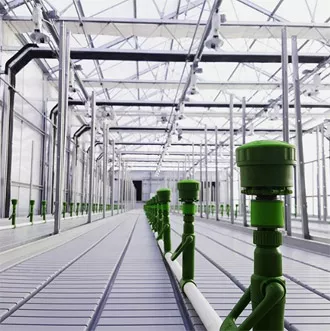
You can measure how much fertilizer is in your growth medium by the EC value. EC stands for Electrical Conductivity, which increases when you have more fertilizer in your growth medium. If your EC concentration is too high, you can negatively stress your crop, but if your EC level is too low, you won’t maximize your potency and your yield.
Another applicable factor is root pressure, which measures how much water gets pulled from the roots up into the plants. Root pressure is also affected by the nutrients contained within the water in your medium of growth. When you flush your plants too much or too quickly, you will put your root pressure in a bad spot if you remove all your salt, because that lowers the pulling power of the water from your plant to the roots.
So, at the end of the growth cycle, growers struggle to balance flushing fertilizer for better taste, with how much stress to add through forced dryness to maximize cannabinoid and terpene potency.
6. Carbon Dioxide (CO2)
Like light and water that we’ve already discussed, CO2 is usually thought of as an essential nutrient for plants, but can be used as a stressor by how and when it is provided.
CO2 is one of the three items plants need for photosynthesis, along with water and light. Growers add extra CO2 to the air in their indoor grow rooms to promote vigorous plant growth. Higher CO2 is very important during the grow stage and the beginning of the flowering stage.
To use CO2 as a stressor is actually about NOT using it. There’s a point when around the last two weeks, and sometimes sooner, when you stop adding extra CO2. If you keep your CO2 at the highest level all the way to your blooming stage, you may grow heavier plants, but won’t maximize your cannabinoid and terpene potency.

Who knew stress could be so good!
So, that was 6 ways to positively stress your plants. These advanced growing methods will take your product to the next level. You can grow batch after batch of healthy cannabis, but without stressing your plants, you’ll never achieve the higher levels of potency possible through stressing. If you want to up your game, you need to level up with stressing.
| 6 ways to positively stress your cannabis plants | |||
|---|---|---|---|
| Stress Factor | Why it Matters | How to Perform | Timing |
| Artificial Lightning | Most important stressor | Add as much light intensity within your system limit and strain choice | After plants get established |
| Canopy Management | Lets you give even more light to plants and flowers | Manage the light penetration to your plants | Series of times as plants establish and grow |
| Temperature | Maintain high terpenes levels | Range of 10 to 20 degree Celsius only at the end of the flowering cycle | Only during the last few days to two weeks of flowering |
| Vapor Pressure Deficit (VPD) | Lets you measure the pace of plant growth during stages of the growth cycle | Keep VPD in range so stomata are less than completely open | Higher VPD near end of flowering cycle |
| Water Irrigation | Stimulates a dry spell | Manage the frequency of watering | As the plant grows, but be especially careful at end of growth cycle |
| Carbon Dioxide | Essential growth ingredient is usually added to foster growth | Stop adding CO2 | Stop adding CO2 during last two weeks or so |
This article was based on an open discussion with Master Grower William Fournier. Will has been involved with the design, cultivation, and operations for several Canadian Licensed Producers. Currently he is involved with commercial LPs, is functioning in Product Development for CANNA, and is preparing to operate his own commercial LP facility.
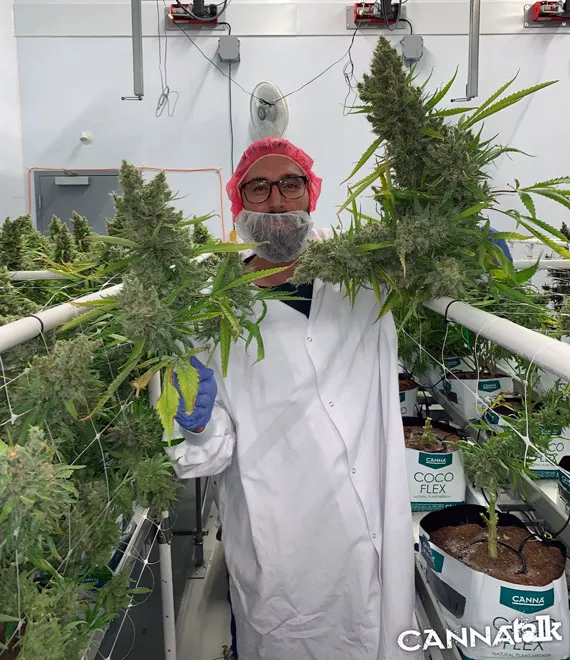
Have Questions? Join our LinkedIn Group!
If you didn’t understand everything in this article and would like to ask questions about it or anything else related to growing cannabis, request to join our CANNAtalk Passionate Growers LinkedIn group by going here.

Members of our LinkedIn group can exchange ideas about Cannabis cultivation techniques, strategies and technologies. We welcome all passionate growers, whether you are a home grower, craft grower, Licensed Producer, or a consultant.
Become a member of our CANNAtalk Passionate Growers LinkedIn group and you’ll also be notified of any future articles we post about your fellow passionate growers and how to grow cannabis better.
More Great Cannabis Cultivation Insights Coming!
Our first Virtual CANNAtalk Experience, The Passionate Growers Hub, on May 27th and June 3rd, 2020, was a great success. Passionate growers of all levels shared their enthusiasm, questions, and expertise, with 70 growers from 40 Canadian towns and cities.
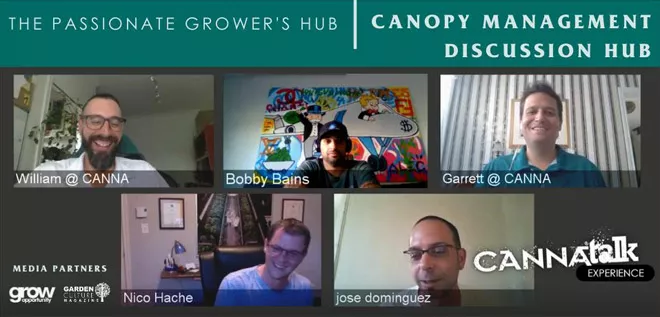
We will share the best ideas from this virtual conference. Keep coming back to our blog to read our upcoming blog posts as we share the best ideas and insights from pioneering Canadian cannabis Lead Growers.









